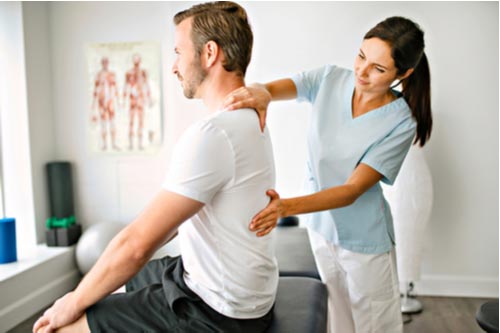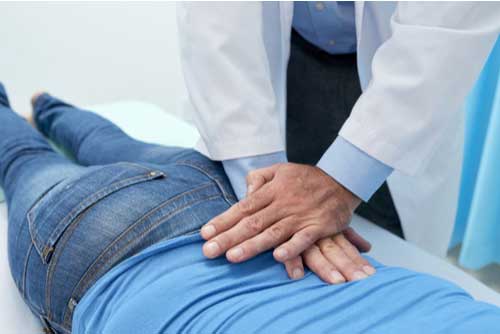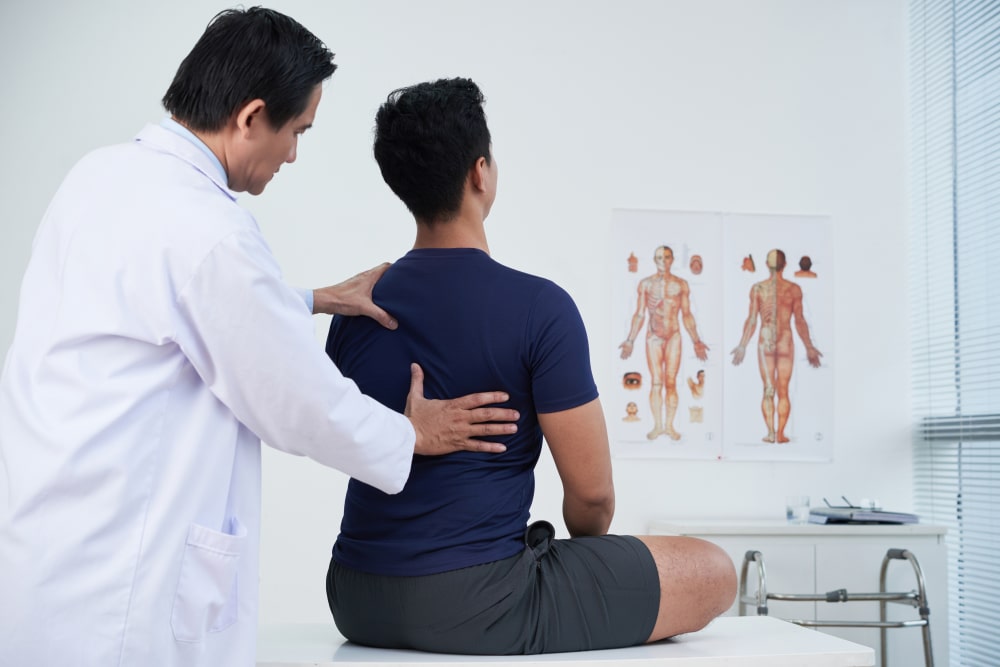It is frustrating when you can’t move as quickly as your colleagues or run and play with your kids because of back pain. You wonder when it will finally go away because it has been bothering you for months. Unfortunately, back pain tends to persist for a long time and can make your life incredibly challenging. Instead of getting frustrated or taking painkillers frequently, you should contact Carolina Spine & Pain.
Our highly experienced team and state-of-the-art facility make Carolina Spine & Pain the best choice for back pain treatment in Greenville, SC. We provide a range of treatments for backaches and we can assure you that your back will become mobile once you follow our treatment methods.
Schedule an appointment at our Greenville injury & pain treatment center today!
Table of Contents
What Causes Back Pain?
Do you know that back pain is a common reason why many people can’t go to work? It is now one of the health problems leading to disability among many people in the world. That doesn’t mean you should panic if you have back pain. It is treatable, provided you follow the treatment instructions carefully. You may also need to change your lifestyle. For example, we may ask you to do free-hand exercises or eat healthy food.
The problem with back pain is that you may not know what exactly caused it in the first place. You can injure your back while playing, exercising, or if you are involved in a physically-demanding job. To know why you have back pain, you need to understand the composition of your back. It consists of discs, tendons, ligaments, muscles, and bones. These elements work in tandem to ensure that your back is moving without any disturbance.
Each segment of your spine contains cartilage-like pads that cushion the vertebrae. Even the slightest injury to the vertebrae may result in back pain. As already mentioned, injury can happen due to poor posture, a physically-demanding job, or while playing.
Here are a few more reasons that can cause back pain:
- Muscle spasm
- Strained muscles
- Damaged discs
- Muscle tensions
- Fractures or falls
- Failed back surgery
The following are some activities that lead to back pain:
- Lifting a heavy object
- Lifting something heavy without following the proper technique
- Abruptly moving your body that jerks your back.
Symptoms of Back Pain
The primary symptom of backache is the constant throbbing of your back. In fact, sometimes, the pain may creep down to your legs and buttocks. The nerves affected by your backache also depend on whether you experience pain in other parts of your body or not. For example, some backaches are so painful that you may feel uncomfortable near your neck and shoulders. You shouldn’t waste time in contacting our Greenville clinic because the quicker we start the treatment, the quicker you can recover.
Our treatment methods are designed to reduce or eliminate pain quickly. But before that, you need to identify the symptoms and convey them to us so that we can select an appropriate treatment method.
Below are the most common symptoms of back pain:
- Swelling or inflammation on your back
- Pain in your buttocks and legs
- Persistent throbbing pain whenever you sit or lie down
- Difficulty in urinating
- Urinary incontinence
- Pain reaches your knees
- Numbness around the problematic area
- Numbness around your buttocks and genitals
It is always best to contact a doctor instead of taking painkillers. Here are a few cases of back pain when you should consult with a doctor immediately:
- If you experience numbness in your legs
- If you accidentally fall or injure your back
- If your backache doesn’t improve even after rest
- If you experience weakness below your back
- If you notice unexplained weight loss

Types of Back Injuries
Many of our patients struggle to perform daily functions and most of them will not relate to being tackled by a friend. It’s not just sports that may injure your back. A few more types of back injuries that you should keep in mind are as follows:
Bulging Disc
A bulging disc injury is similar to a ruptured disc. In this case, the cushioned discs in the vertebra slip and thus put more pressure on the nerves. When you have bulging discs, you may not be able to move properly without any support. Although bulging discs and ruptured discs may seem similar, the former is more painful.
Herniated Disc
A herniated disc occurs just prior to a bulging disc. If the jelly-like substance between the vertebrae slips and causes bone-on-bone friction, this is considered a bulging disc. Oftentimes sudden jerking or injuring one’s back while lifting something heavy may lead to a herniated disc.
Nerve Damage
Doctors call this condition cauda equina syndrome. It arises when the bundle of nerve roots in the bottom half of your spinal cord gets damaged. Not treating your back pain for years may lead to cauda equina syndrome. You may experience numbness in your back, thighs, genitals, and a dull pain along your buttocks and lower back.
Fractures
Sometimes, you may not realize that there’s a hairline fracture in your back. We can detect the fracture by performing X-rays or CAT scans. Tell us in detail how you fell down or injured your back and we can decide how to diagnose the reason for the fracture.
Soft Tissue Injuries
Soft tissue injuries take place while exercising or playing. Contusions, sprains, and strains also contribute to your backache. They affect your ligaments, tendons, and muscles.
How Will Your Doctor Diagnose Your Back Injury?
The first step to recovering from a back injury is to share everything with your doctor. Detail how your injury occurred and let your doctor know about your daily life (work, hobbies, etc.) and what exacerbates your back pain. This will help the doctor diagnose the source of your pain.
Here are a few ways we usually diagnose back injuries:
A Physical Exam
We always start by physically examining your back. The doctor may press on certain regions to determine whether the disc is ruptured, herniated, or bulging. Once he understands the cause of the back pain, he can create an appropriate treatment method.
A CAT Scan
A CAT scan clearly shows whether you have a herniated disc or not. It also detects signs of problems with your nerves, tendons, blood vessels, tissues, bones, muscles, and ligaments. We usually perform a CAT scan if the pain is too severe or if we think that there can be multiple reasons for your backache.
An MRI
An MRI provides a detailed picture of your bones, muscles, ligaments, and tendons. We can quickly identify the injured area and then work on it to help you recover from the persistent pain.
An X-Ray
X-rays show your bones’ alignment to detect signs of whether you have a hairline fracture. However, an x-ray is not as effective as a CAT scan or an MRI as it doesn’t reveal damages to your spinal cord, discs, nerves, or muscles.

Types of Treatment
At Carolina Spine & Pain Greenville, we provide a range of treatment methods to treat both lower back pain and upper back pain. We first assess your condition by physically examining your back or performing the above-mentioned scans. Once we diagnose the condition and figure out the cause of your injury, we move on to providing the treatment that can help you recover quickly.
Following are some of our treatment methods that can effectively treat back pain:
Medication Management
We may provide over-the counter medications that reduce your pain and may allow for more mobility and daily function. In certain cases, your provider may determine there is a need for prescription medications.
Radiofrequency Ablation
Radiofrequency ablation is a procedure during which we ablate nerves which send pain signals using heat generated from frequency alternating current.
Nerve Blocks
In this treatment method, we deliberately block the nerves that cause irritation or pain in your back.
Spinal Cord Stimulator
A spinal cord stimulator is an implantable neuromodulation device that sends electrical signals to your back, including your spinal cord. We provide this treatment to patients who experience back pain due to nerve damage. The controlled electrical signals ensure that the nerves become active instead of remaining dormant.
Injections
Cortisone injections are highly effective in treating long-term back pain. Injury to your spine or hip may cause a tremendous amount of back pain, and if none of the other treatment methods work, we will often recommend a cortisone injection to reduce the inflammation around the affected nerve roots.
Chiropractic Adjustments
Chiropractic adjustments involve manipulating the patient’s spine to reduce backaches and improve spinal alignment.
Orthopedic Surgery
Several orthopedic surgeries that may reduce your back pain are artificial disc, fusion, partially removing the vertebrae, and discectomy.
Kyphoplasty
Kyphoplasty is a minimally invasive procedure during which your provider will use a tiny balloon through a needle to re-inflate the vertebral body to its original height. He will then use a quick-drying bone cement to repair the fractured vertebra.
Get Effective Back Pain Treatment in Greenville, SC
Back pain can slowly become so uncomfortable that you may not be able to sleep properly. Don’t let your backache go untreated. At Carolina Spine & Pain, we can help relieve your back pain. We have a state-of-the-art facility and our team has decades of combined experience.
Don’t wait to start back pain treatment in Greenville, SC. Contact us at 864-532-4664.

